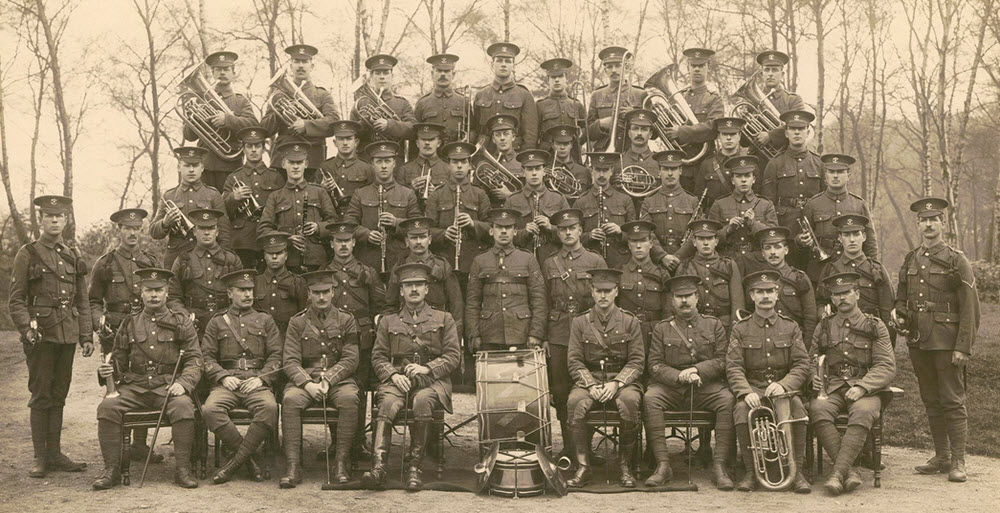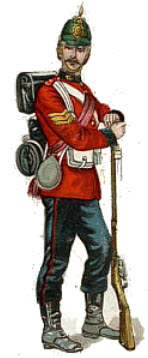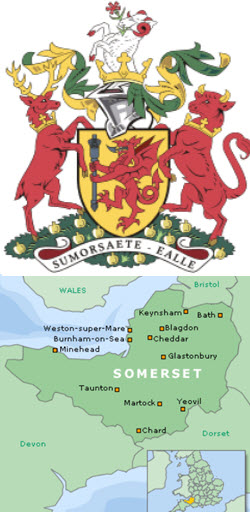Contents

The Somerset Light Infantry (Prince Albert’s) was a light infantry of the British Army from 1685 to 1959. In 1959, the Somerset Light Infantry formed the Somerset and Cornwall Light Infantry together with the Duke of Cornwall’s Light Infantry.
Short facts about the 13th Regiment of Foot – Somerset Light Infantry (Prince Albert’s)
| Active | 1685–1959 |
| Country | Kingdom of England (to 1707) Kingdom of Great Britain (1707–1800) United Kingdom (1801–1959) |
| Branch | British Army |
| Type | Infantry |
| Role | Light infantry |
| Garrison/HQ | Jellalabad Barracks, Taunton |
| Colours | Yellow facings until 1842, blue thereafter |
| March | Prince Albert’s March |
| Engagements | Nine Years War War of the Spanish Succession War of 1812 First Anglo-Afghan War Second Boer War First World War Second World War Malayan Emergency Suez Crisis |
| Victoria Cross recipients | Lieutenant George Albert Cairns
Private Patrick Carlin Major William Knox Leet Sergeant William Napier Private Thomas Henry Sage |
Colonels
Colonels of Earl of Huntingdon’s Regiment of Foot
| 1685–1688: Col Theophilus Hastings, 7th Earl of Huntingdon |
| 1688–1695: Col Ferdinando Hastings |
| 1695–1702: Col Sir John Jacob |
| 1702–1715: Lt-Gen James Barry, 4th Earl of Barrymore |
| 1715–1725: Col Stanhope Cotton |
| 1725–1732: Gen Lord Mark Kerr |
| 1732–1739: Brig-Gen John Middleton |
| 1739–1766: Gen Hon Harry Pulteney |
Colonels of the 13th Regiment of Foot
| 1766–1767: F.M. HRH William Henry, 1st Duke of Gloucester |
| 1767–1789: Gen Hon James Murray |
Colonels of the The 13th (1st Somersetshire) Regiment of Foot
| 1789–1804: Gen George Ainslie |
| 1804–1813: Gen Alexander Campbell |
| 1813–1843: Gen Edward Morrison |
Colonels of the The 13th (1st Somersetshire) Prince Albert’s Light Infantry
| 1843–1846: Major-Gen Sir Robert Henry Sale GCB |
| 1846–1863: F.M. Sir William Maynard Gomm GCB |
| 1863–1864: Major-Gen Philip McPherson |
| 1864–1880: Gen Philip Spencer Stanhope |
Colonels of the The Somerset Light Infantry (Prince Albert’s)
| 1880–1900: Gen Lord Mark Ralph George Kerr GCB |
| 1900–1901: Lt-Gen Sir John William Cox KCB |
| 1901–1910: Major-Gen Edward Lutwyche England CB |
| 1910–1914: Major-Gen Sir Henry Hallam Parr KCB CMG |
| 1914–1919: Major-Gen Richard Lloyd Payne CB DSO |
| 1919–1929: Lt-Gen Sir Thomas D’Oyly Snow KCB KCMG |
| 1929–1938: Gen Sir Walter Pipon Braithwaite GCB |
| 1938–1947: Major-Gen Vivian Henry Bruce Majendie CB DSO |
| 1947–1953: Lt-Gen Sir John George des Reaux Swayne KCB CBE |
| 1953–1959: F.M. Sir John Harding, Ist Lord Harding of Petherton GCB CBE DSO MC |
Dress and insignia
Facings
When the regiment was formed in 1685, they were given red coats with a yellow coat lining. The yellow lining was visible at the turned back cuffs, skirts and lapels.
Later, when the style of the uniform was changed, and yellow was used for the collar and cuffs of the jacket or tunic.
 The facing colours of the “Marching Regiments on Foot” was regulated by royal warrant in 1751 and the 13th Foot (Lieutenant-General Pulteney’s Regiment) was assigned the colour “philemot yellow” as their facing colour. The word philemot is a corruption of the French feuille morte which means dead leaf. So, the facing colour of the 13th Foot was the yellow of an autumn leaf.
The facing colours of the “Marching Regiments on Foot” was regulated by royal warrant in 1751 and the 13th Foot (Lieutenant-General Pulteney’s Regiment) was assigned the colour “philemot yellow” as their facing colour. The word philemot is a corruption of the French feuille morte which means dead leaf. So, the facing colour of the 13th Foot was the yellow of an autumn leaf.
In 1842, the 13th Foot became a royal regiment and given the title “Prince Albert’s”. As a part of this change, their facings were changed from yellow to dark blue.
Light infantry distinctions
The regiment was granted light infantry distinctions in 1822. As late as the full dress of 1914, we can see this surviving in the form of a bugle-horn in the badge and the dark green home service helmet worn instead of the dark blue ones used by the line infantry.
The forage cap and postwar No.1 dress uniform worn by the Somerset Light Infantry were also dark green.
Officer’s coats
In 1830, the braid and lace worn by officer’s coats in the 13th Foot was changed from silver to gold.
Sergeants’ sash
At the Battle of Culloden in Scotland in 1745, a large number of officer’s from 13th Regiment of Foot were fatally wounded and the sergeants took command. To commemorate this, warrant offers and sergeants of the 13th Regiment of Foot began wearing their sashes over the left shoulder and tied on the right side, in the same manner as officers. This was a distinction unique to the 13th Regiment of Foot, authorized in 1865. Prior to this, the sashes were worn like this without authorization.
In 1898, officers of all regiments were ordered to wear the sash knotted on the left side, with the exception of the 13th Regiment of Foot who were permitted to continue with the knot on the right.
Badges
- The first distinctive badge awarded to the 13th Regiment of Foot was a sphinx, a badge awarded to the infantry in the year 1802 for its service in Egypt.
- When the 13th Regiment of Foot was converted into light infantry in 1822, they adopted a bugle-horn with strings for their shako head-dress. The bugle-horn featured the number 13 in the centre and was surmounted by the sphinx. When a new model of shako came into use in 1844, a mural crown and scroll inscribed Jellalabad were added.
- Khaki service dress with a slouch hat was introduced for the Somerset Light Infantry in 1898 and a metal badge was created for the hat. The metal badge sported the bugle-horn, the mural crown and the scroll with the word Jellalabad. On the strings of the bugle-horn, the cypher PA was added. (PA = Prince Albert.)
The names
It would take quite a long time before this regiment began using the name Somerset Light Infantry. Until the late 17th century, the regiment was simply known by the name of its current colonel. It thus went from being Earl Huntingdon’s Regiment of Foot to becoming Hasting’s Regiment of Foot, and so on, throughout the 1600s. By 1742, it was fighting in the War of Austrian Succession under General Harry Pulteney and was thus known there as Pulteney’s Regiment of Foot.
This naming practice was changed in 1751, when a royal warrant was issued, stipulating that regiments should be known by their individual number. As early as the late 1600s, each regiment of the standing British army had bee given an individual number that showed their “rank” in the order of precedence. From 1751, Pulteney’s Regiment of Foot was formally know as the 13th Regiment of Foot.
The 13th Regiment of Foot enjoyed a 30 year long period of garrison service in England, Ireland, Gibraltar and Minorca. When the American Revolutionary War broke out, the regiment was sent to Barbados but saw little active service before returning to England in 1782.
In August 1782, all English regiments on foot received an English county designation, unless they were royal regiments or highland regiments. The intention was to make it easier to recruit soldiers to the regiments.
My Lord,
The very great deficiency of men in the regiments of infantry being so very detrimental to the public service, the king has thought proper to give the names of the different counties to the old corps, in hopes that, by the zeal and activity of the principal nobility and gentry in the several counties, some considerable assistance may be given towards recruiting these regiments”.
– Secretary of War, Thomas Townshend in a letter issued to the lieutenants of each English county
This is how the 13th Regiment of Foot became the 13th (1st Somersetshire) Regiment of Foot. At the same time, the 40th Regiment of Foot became the 40th (2nd Somersetshire) Regiment of Foot.
The name change didn’t impact recruitment much. Just as before, the regiments found it easier to recruit in major population centres rather than focus on a specific county.
Amalgamations
In 1959, the Somerset Light Infantry was amalgamated with the Duke of Cornwall’s Light Infantry to form the Somerset and Cornwall Light Infantry.
In 1968, the Somerset and Cornwall Light Infantry was amalgamated with the King’s Own Yorkshire Light Infantry, the King’s Shropshire Light Infantry and the Durham Light Infantry to form The Light Infantry.
In 2007, The Light Infantry was amalgamated with the Devonshire and Dorset Regiment, the Royal Gloucestershire, Berkshire and Wiltshire Regiment, and the Royal Green Jackets to form The Rifles.

